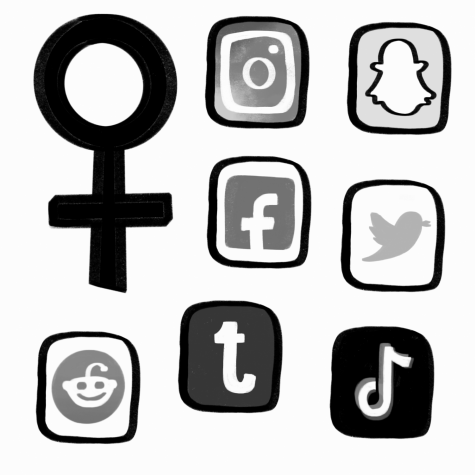The problem with “choice feminism”
April 1, 2021
In 1968, women flung girdles, Playboy magazines and bras into a trash can, symbolically freeing themselves from the instruments of their oppression. In the coming decades, scores of women declined to take their husbands’ surnames after marriage, renouncing the tradition and its roots in female coverture. Now in the twenty-first century, young women all over social media proudly tout the aforementioned items as empowering, and only 20 percent of women opt to keep their last names. What happened?
This is not a judgment of these women, nor is it an undiscerning endorsement of late twentieth-century feminism. Second-wave feminism, a movement that broadened the scope of feminism from foundational legal rights, had many problems: it catered chiefly to middle- and upper-class white women, ignoring the plight of women of color and working-class women. Its blatant and unapologetic rejection of the markers of patriarchy was not among these problems, though the prevailing voices of modern feminism might disagree.
The wave of feminism under which I came of age seems to concede to the (mostly male) pushback received during second-wave feminism. We recede into the safety of individual choice, distancing ourselves from the brash, homely bra-burners of the ‘70s. Now, it seems that any action, choice or product can be a feminist one as long as it is labeled as such. “Choice feminism,” which emerged alongside post-feminist ideology, tells us that all individual choices made by women are inherently feminist. This effectively takes the bite out of feminism, making it palatable to the mainstream and also arguably ineffectual.
Choice feminism argues, for instance, that a woman’s decision to stay at home is equally as feminist as another woman’s decision to work because they are both exercising their right to choose. I unequivocally support the rights and dignity of stay-at-home moms and housewives, but their choices were not formed in a vacuum; like all of ours, they were shaped by years of socialization under patriarchy. It isn’t productive to uncritically laud each choice a woman makes while ignoring the factors that led up to it.

Admittedly, actual third-wave feminist theory, sprouting from Black feminist scholars and punk subcultures, is radical and plenty subversive. The main culprit of this move to defanged, marketable feminism seems to be social media. Platforms like Instagram, Twitter and Tumblr have allowed for the wide dissemination of feminist thought, making feminism more mainstream than ever.
At first glance, this may seem like a cause for celebration — seemingly more women and girls are identifying with the label of “feminist” than ever, and social media has made feminist ideology far more accessible and readily available to the public. However, social media has presented us with a somewhat lackluster cousin of feminism, due both to its bite-sized format and the drive to make things marketable, palatable and aesthetically pleasing.
It’s been a convenient trajectory for companies, who have readily slapped “feminist” on their products, sat back and profited. Feminism, like many other social movements, has been completely commodified. The same products that women tossed into the “Freedom Can” in 1968 are now marketed as inherently empowering, and for the most part, they’ve succeeded. We’ve internalized it.
These days, mainstream feminism feels more like an aesthetic or an identifier than a commitment to radical change. While social media plays a vital role in spreading information and fueling activism, it has certainly taken a toll on the foundation of feminism, diluting it for mainstream appeal and commodification. A massive reframing of the word and the movement are in order — after all, “feminist” isn’t a dirty word, but who cares if it is?








Angela • Jul 8, 2022 at 1:41 pm
I agree that any entity that is requires or expects women to be dependent on men is inherently sexist, anti-feminist and works in the opposite direction of equality. This is seen in all areas of the sex industry where women and girls primarily, with no or few other options, are paid or forced to pander to men’s emotional and sexual wants, regardless of the girls or women’s wants, needs and often times safety. The majority of the sex industry has always been dependent on men’s patronage and men’s money in order to exist and supplied with girls’ and women’s physical and emotional labor. Additionally any entity that requires women to dress, think, behave in a particular way that is not required or expected of men is also inherently sexist and anti-feminist, particularly the entertainment, beauty and fashion industries.
I agree that none of these “choices” to engage in such behavior exist in a vacuum. As is everything, they are interconnected with society’s beliefs and values (however ridiculous , bigoted or narcissistic they might be). The good news is, it just takes one person going against the grain to get the ball rolling in the opposite direction again (or at least slow it down). One person may not make a big difference, but influence is exponential. I do what I can, when I can, when I feel it appropriate to educate and make my position known. It works. Look at the newest ads for Victoria’s Secret, even with all their disgustingly sexist business practices (like airing “fashion” shows to fulfill straight men’s desires, not women’s who they actually sell to) and links to sex trafficking, they are joining the inclusivity and diversity movement.
Gendered psychology is one of the biggest enablers of sexism outside of the previous listed industries. Reading articles and books that tout the differences in male vs female brains, behavior and thoughts, that conveniently leave out social conditioning, generational trauma or grooming, inspires me to question whether or not a degree actually means they understand anything about the topic they’re writing about at all. I usually find myself rolling my eyes when these authors try to justify things such as oppression, abuse and exploitation using circular reasoning and outdated gender stereotypes.
My personal favorite response is a whole hearted, “F*** you, buddy.” when a stranger thinks they know me better than I know myself, just because of my chromosomes and what’s between my legs. I’ve been told several times that I think more like a man than a woman anyway, which is complete BS, logically speaking. I am genetically female, therefore I think like a woman, duh.
Will • May 15, 2021 at 12:07 pm
any difference at all between the aggregate choices of men and women is always patriarchy. okay.
Anto • Jan 20, 2023 at 11:37 am
It comes from established social expectations, but yeah at a certain level, why question them, otherwise freely chosen hijab would be another can of worms, but that’s recognized as a patriarchal even by otherwise antifeminist conservatives somehow.
Dee • Apr 2, 2021 at 11:54 am
” but their choices were not formed in a vacuum; like all of ours, they were shaped by years of socialization under patriarchy.”
And your choice to say that they do not have the mental free will to make that decision on their own flies right back at you.
Anyone can easily argue you too, have been programmed and mentally conditioned to join this
anti-choice ” my feminism is true feminism” crusade as not of YOUR OWN choosing.
Your position also does not exist in a vacuum. You too can easily be labeled as someone from an indoctrination camp.